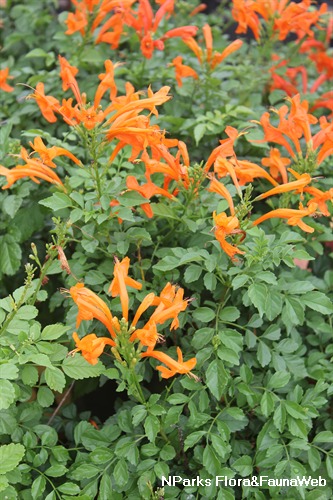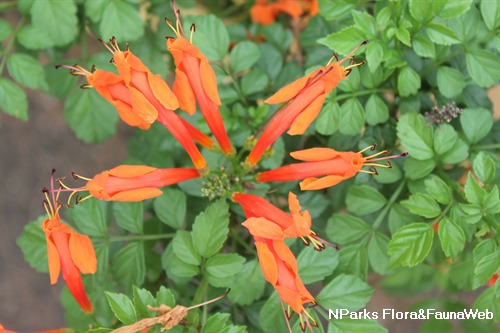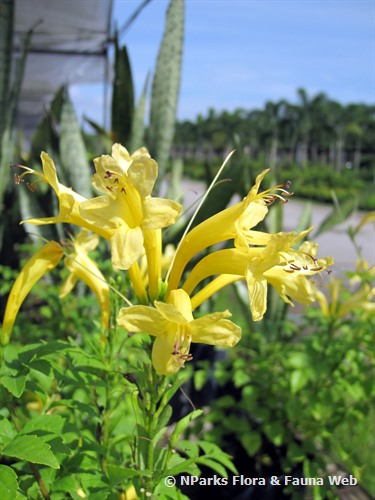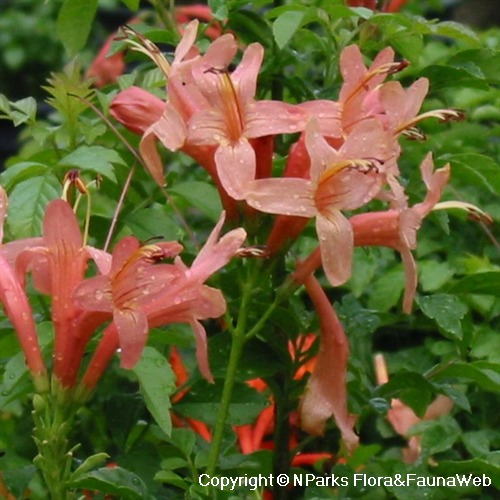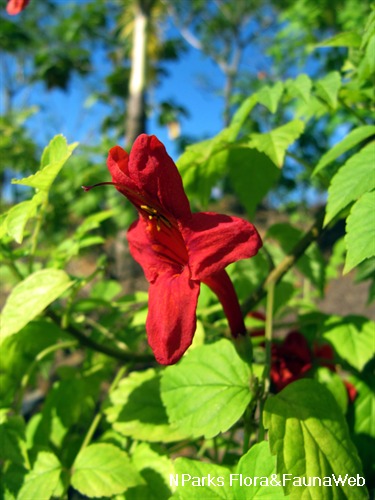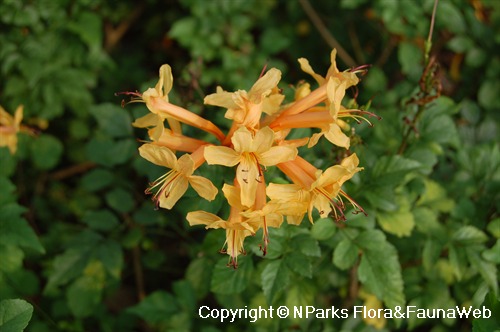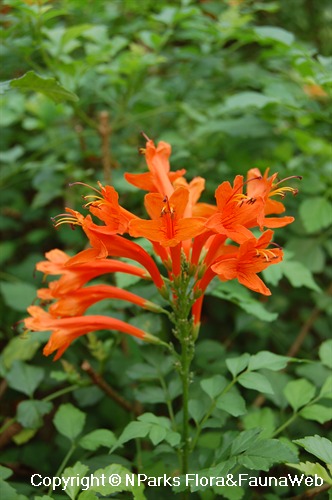
Back
Tecomaria capensis (Thunb.) Spach
| Family Name: | Bignoniaceae |
| Synonyms: | Bignonia capensis, Tecoma capensis |
| Common Name: | Cape Honeysuckle, West Indian Honeysuckle, 硬骨凌霄, 南非凌霄花 |
The Cape Honeysuckle (Tecomaria capensis) is an evergreen shrub with clusters of bright orange-red trumpet-shaped flowers. This shrub flowers best under full sun but can tolerate partial shade. It can be planted in mass for hedge, espalier or in a container.
Name
Classifications and Characteristics
| Plant Division | Angiosperms (Flowering Seed Plants) (Dicotyledon) |
|---|---|
| Plant Growth Form | Shrub |
| Lifespan (in Singapore) | Perennial |
| Mode of Nutrition | Autotrophic |
| Maximum Height | 2 m to 2.5 m |
| Maximum Plant Spread / Crown Width | 2.5 m |
Biogeography
| Native Distribution | Angola, Cape Provinces, KwaZulu-Natal, Malawi, Mozambique, Northern Provinces, Swaziland, Tanzania, Zaire |
|---|---|
| Native Habitat | Terrestrial (Grassland / Savannah/ Scrubland) |
| Preferred Climate Zone | Sub-Tropical / Monsoonal |
| Local Conservation Status | Non-native (Horticultural / Cultivated Only) |
Description and Ethnobotany
| Growth Form | Evergreen shrub to 2.5m tall with semierect-scandent habit. |
|---|---|
| Foliage | Shiny green leaves are oppositely arranged, pinnately compound (15 cm long). They are composed of 2 - 9 toothed, elliptic-ovate leaflets. |
| Flowers | Orange-red tubular flowers (3.5 - 4.5 cm long) have 5 unequal lobes and a long protruding style (filament-like tip of the female organ). Flowers occur in clusters near the branch tips. |
| Fruit | Dry, dehiscent fruits are known as capsules, up to 7.5 cm long. |
| Cultivation | This fast-growing species should be planted in fertile, well-drained soil that is mildly acidic to mildy alkaline. Allow 0.6 - 0.9 m of spacing between individuals. It flowers best under full sun, but also tolerates light shade. |
| Ethnobotanical Uses | Food (Herb or Spice) Medicinal: Powdered bark used traditionally to relieve pain and insomnia. Leaf extracts found by modern researchers to possess anti-fungal properties. |
Landscaping Features
| Desirable Plant Features | Ornamental Flowers |
|---|---|
| Landscape Uses | General, Hedge / Screening, Container Planting |
| Thematic Landscaping | Naturalistic Garden |
Fauna, Pollination and Dispersal
| Fauna Pollination Dispersal Associated Fauna | Bird-Attracting |
|---|---|
| Pollination Method(s) | Biotic (Fauna) |
| Seed or Spore Dispersal | Abiotic (Explosive Dehiscence), Biotic (Fauna) ( Aaptos suberitoides . Seeds have large papery wings which are dispersed by wind. ) |
Plant Care and Propagation
| Light Preference | Full Sun |
|---|---|
| Water Preference | Moderate Water |
| Plant Growth Rate | Fast to Moderate |
| Rootzone Tolerance | Easy to Grow, Well-Drained Soils, Moist Soils |
| Propagation Method | Stem Cutting |
Foliar
| Foliage Retention | Evergreen |
|---|---|
| Mature Foliage Colour(s) | Green |
| Mature Foliage Texture(s) | Smooth, Thin |
| Prominent Young Flush Colour(s) | Green |
| Young Flush Texture(s) | Smooth, Thin |
| Foliar Type | Compound (Odd-Pinnate) |
| Foliar Arrangement Along Stem | Opposite |
| Foliar Attachment to Stem | Petiolate |
| Foliar Shape(s) | Non-Palm Foliage (Elliptical, Ovate) |
| Foliar Venation | Pinnate / Net |
| Foliar Margin | Serrate / Toothed |
| Leaf Area Index (LAI) for Green Plot Ratio | 4.5 (Shrub & Groundcover - Dicot) |
Non - Foliar and Storage
| Stem Type & Modification | Woody |
|---|---|
| Root Type | Underground |
Floral (Angiosperm)
| Flower & Plant Sexuality | Bisexual Flowers |
| Flower Colour(s) | Orange, Red |
|---|---|
| Flower Texture(s) | Smooth |
| Flower Grouping | Cluster / Inflorescence |
| Flower Location | Terminal |
| Flower Symmetry | Bilateral |
| Individual Flower Shape | Trumpet-shaped |
| Flowering Period | Free-Flowering |
| Flower Size | 4.5 cm |
Fruit, Seed and Spore
| Fruit Classification | Simple Fruit |
|---|---|
| Fruit Type | Dehiscent Dry Fruit , Capsule |
References
| References | <1> eFloras (2008). http://www.efloras.org .Missouri Botanical Garden, St. Louis, MO & Harvard University Herbaria, Cambridge, MA. Accessed 26 July 2024. |
|---|
Image Repository
Others
| Master ID | 1205 |
|---|---|
| Species ID | 2498 |
| Flora Disclaimer | The information in this website has been compiled from reliable sources, such as reference works on medicinal plants. It is not a substitute for medical advice or treatment and NParks does not purport to provide any medical advice. Readers should always consult his/her physician before using or consuming a plant for medicinal purposes. |

